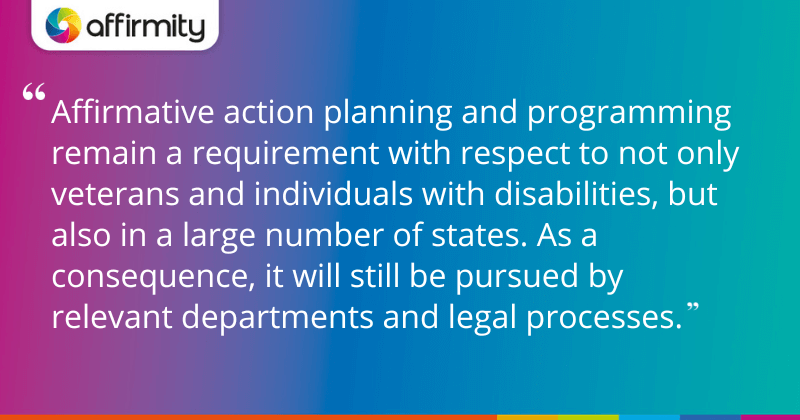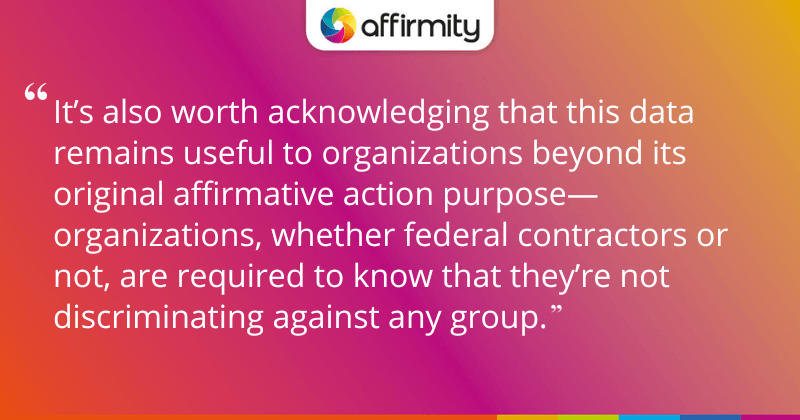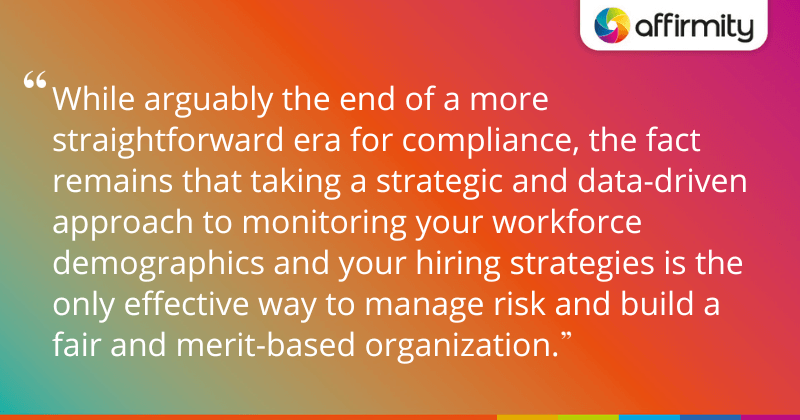Executive Order 11246 is no more. So does your organization still need to develop an affirmative action plan? The answer may surprise you. In this article, Affirmity’s VP of Sales, Kim Hendon, looks at why affirmative action hasn’t fully gone away and considers some important questions you may have about your affirmative action obligations in our new context.
When Are Federal Contractors Now Required to Develop an Affirmative Action Plan?
When Executive Order 11246 was revoked in January 2025, the requirement for creating race and gender-related affirmative action plans was removed. However, affirmative action persists as a practice for two key groups: veterans and individuals with disabilities.

Vietnam Era Veterans’ Readjustment Assistance Act (VEVRAA)
Employers with 50 or more employees and $150,000 or more in federal contracts must develop a veteran-focused affirmative action program (AAP). This includes setting an annual hiring benchmark (or adopting the national benchmark typically set each year by the OFCCP), inviting applicants and employees to self-identify, and listing jobs with relevant state Employment Service Delivery Systems (ESDSs).
These employers are additionally required to train managers on:
- Veteran categories
- Outreach and job listing compliance
- Self-identification process best practices
Section 503 of the Rehabilitation Act
The requirement to create a Section 503-related affirmative action program comes into effect when an organization has 50 or more employees and $50,000 or more in federal contracts. Similar to VEVRAA, employers must set utilization goals for individuals with disabilities (usually the current nationwide utilization goal), and invite voluntary self-identification by employees.
They must additionally provide training on the company’s affirmative action commitments to individuals involved in recruitment, screening, selection, promotion, disciplinary, and other related processes. This training should include, but is not limited to:
- Accommodation processes
- Self-ID and confidentiality processes
- Inclusive best practices
When Does the Requirement to Develop an AAP Come Into Effect?
As per Title 41, both VEVRAA and Section 503 require eligible contractors to prepare and maintain their affirmative action programs within 120 days of contract commencement. Therefore, as soon as a contract is in place, organizations will want to proactively start pulling together all required information immediately, as the process of creating an AAP can be time-consuming.
Can These AAPs Be Combined?
The sections of Title 41 referenced above also state that “This program may be integrated into or kept separate from other affirmative action programs.” Therefore, if your organization meets the “50 or more employees and $150,000 or more in federal contracts” requirement for having a VEVRAA-related program, you have the option of combining it with your Section 503 AAP.
CATCH UP ON THESE ADDITIONAL COMPLIANCE FAQs | ‘11 Essential Answers to Your Frequently Asked Questions on Non-Discrimination Best Practices’

Are There Any Other Reasons to Continue Conducting AAP-Related Analysis?
Though race and gender-related affirmative action plans are no longer mandatory for federal contractors, the data collection and analysis practices they involved remain valuable.
On the subject of adverse impact analyses, Affirmity Principal Business Consultant, Patrick McNiel, PhD, recently gave a number of compelling reasons why that particular risk assessment tool was worth retaining despite the stance of the current administration. Some of the arguments listed there could equally be applied to affirmative action planning, namely:
- Affirmative action planning and programming remain a requirement with respect to not only veterans and individuals with disabilities, but also in a large number of states. As a consequence, it will still be pursued by relevant departments and legal processes.
- Affirmative action in employment has ultimately always been focused on ensuring the merit-based goals that the current wave of executive orders claim to espouse. By continuing to analyze and measure their workforce, organizations can provide a statistical foundation that justifies selection decisions.
- Under EO 14173, section 3 (iv) (A) & (B) contractors must certify “compliance in all respects with all applicable federal anti-discrimination laws” and that it “does not operate any programs promoting DEI that violate any applicable anti-discrimination laws”.
- Future administrations could theoretically reinstate affirmative action requirements, and those organizations that have continued with analyzing the workforce will have a significant head start on compliance—and ultimately reduce risk in future investigations.
- Continuing to uphold affirmative action processes and principles will ensure that your business is seen to maintain a consistent moral and ethical stance. This appeals to job candidates, employees, customers, investors, and the wider community.
READ ANOTHER VIEW ON THE CONTINUING APPLICABILITY OF AFFIRMATIVE ACTION | ‘Open Letter From Former U.S. DoL Officials Suggests Way Forward for Non-Discrimination Programs’
Other Uses of Affirmative Action Data
It’s also worth acknowledging that this data remains useful to organizations beyond its original affirmative action purpose—organizations, whether federal contractors or not, are required to know that they’re not discriminating against any group. Considering recent executive orders and subsequent guidance have been short on detail regarding exactly how to check for this, the legacy approach to affirmative action still presents a robust model for building this body of evidence.
For a case in point, Affirmity’s affirmative action dashboards have evolved into workforce insights dashboards. We’ve surfaced statistics on whites and males alongside other groups (the data was always available; it just wasn’t as prominent), and made a few minor tweaks in terms of core functionality. We believe that these dashboards continue to serve an important function as more general-purpose equal employment opportunity plans that can ensure compliance, guard against risk, and build inclusion.
Organizations that do business in the U.S. have several non-affirmative action-related compliance obligations. Conducting programs akin to legacy affirmative action efforts can be beneficial for meeting these obligations. Federal contractors have the following compliance requirements:
- VETS-4212 Reporting: If a federal contractor has 50+ employees and $150,000+ in federal contracts, they must report employment data for protected veterans and number of hires over the previous 12 months.
- Uniform Guidelines on Employee Selection Procedures (UGESP): Requires most employers with 15+ employees to monitor for adverse impact in their employment practices. This requires employers to collect data on applicants, hires, and selection steps.
- Recordkeeping: All contractors must maintain employment records—hiring, compensation, training, promotion, and termination— for at least one year. Contractors with more than 150 employees or $150,000 in contracts must maintain these records for at least two years.
All U.S. employers are additionally subject to the following:
- Equal Pay Act of 1963: A federal law that requires equal pay for equal work between men and women, enforced by the EEOC. Many employers voluntarily conduct pay equity analyses to prepare for potential audits, complaints, or litigation.
- EEO-1 Reporting: All U.S. employers with 100 or more employees submit workforce demographic data by job category, sex, and race or ethnicity to the EEOC annually.
- Title VII of the Civil Rights Act of 1964: Prohibits employment discrimination based on race, color, religion, sex, and national origin. Employers commonly conduct workforce analysis and training to proactively identify and prevent illegal discrimination.
- U.S. Department of Health and Human Services (HHS) New Hire Reporting: Employers must report basic information on new and rehired employees within 20 days of hire. This is used to update a directory that tracks owed child support payments.
KEEP TRACK OF CURRENT BEST PRACTICES | ‘Your Post-EO 11246 Non-Discrimination Best Practice Checklist’

Other Forms of Affirmative Action to Be Aware Of: The Case of States
Many U.S. states have local laws requiring affirmative action plans and policies that remain in effect regardless of federal changes. The scope of these laws varies widely from state to state—with some combination of state agencies, contractors, and universities usually covered. We have attempted to categorize these measures below. The resulting list primarily illustrates how widespread these laws are, and may prompt a conversation with your legal counsel to ensure that you remain locally compliant.
States and Territories With Affirmative Action for Contractors at Specific Thresholds
All private employers that have contracts with state entities in the following jurisdictions must create an affirmative action or Equal Employment Opportunity plan if they reach a certain employee and/or contract value threshold.
- Arizona
- California
- Iowa
- Kansas
- Kentucky
- Maine
- Minnesota
- New Jersey
- New York
- Ohio
- Oregon
- Pennsylvania
- Rhode Island
- Washington DC
- Wisconsin
States With Affirmative Action for Contractors on Specific Contracts
In the following states, affirmative action requirements are only written into specific contract types, such as public works or construction contracts. They may also be required based on other criteria that may not be publicly available.
- Alaska
- Connecticut
- Illinois
- Maryland
- Oklahoma
- Wyoming
States With No Affirmative Action Measures But Other Anti-Discrimination Clauses
Though the following states do not require private employers to produce affirmative action plans, they do have other nondiscrimination measures that private employers should research.
- Arkansas
- Colorado
- Delaware
- Florida
- Georgia
- Hawaii
- Indiana
- Louisiana
- Massachusetts
- Michigan
- Nebraska
- Nevada
- New Mexico
- North Carolina
- North Dakota
- South Carolina
- Texas
- Utah
- Vermont
- Virginia
- Washington State
States With No Measures Other Than Federal Requirements for Private Employers
The following states do not appear to have any laws for private employers. However, it’s important to note, that while there may not be any specific state mandates, most contracts will contain a clause that requires compliance with all “applicable law” which would include federal non-discrimination compliance laws.
- Alabama
- Idaho
- Mississippi
- Missouri
- Montana
- New Hampshire
- South Dakota
- Tennessee
- West Virginia
LEARN ABOUT ANOTHER ASPECT OF STATE-LEVEL—AND GLOBAL— COMPLIANCE | ‘Pay Equity Reporting Around the World’
In Conclusion: Coping With Increasingly Patchwork Requirements
The end of race and gender-based affirmative action may not have been the end of all forms of affirmative action, but it was arguably the end of a more straightforward era for compliance. While it’s true that the remaining federal and state measures have existed for many years, the lack of a larger federal-level requirement for affirmative action means organizations may wrongly feel they can discontinue programs they’re still required to maintain.
The picture described here could also change dramatically over the coming years. Some states may use the current administration’s stance as a prompt to remove their requirements, while others may instead decide to double down. The federal picture itself remains uncertain at this time—further guidance is still forthcoming.
The fact remains that taking a strategic and data-driven approach to monitoring your workforce demographics and your hiring strategies is the only effective way to manage risk and build a fair and merit-based organization.
Navigate the growing complexity of compliance with Affirmity: Contact us today for more information.
About the Author
 Kim Hendon oversees account management and sales for Affirmity. She is responsible for building successful, long-term partnerships with clients and generating new business. Having served with the company for more than 25 years, Ms. Hendon has in-depth knowledge and broad experience in all areas of workforce analytics and HR compliance. Ms. Hendon assists clients with the planning and development of workforce compliance and non-discrimination programs, as well as employee engagement initiatives. She holds a Bachelor of Arts in Speech Communication and a Master’s in Business Administration. Connect with her on LinkedIn.
Kim Hendon oversees account management and sales for Affirmity. She is responsible for building successful, long-term partnerships with clients and generating new business. Having served with the company for more than 25 years, Ms. Hendon has in-depth knowledge and broad experience in all areas of workforce analytics and HR compliance. Ms. Hendon assists clients with the planning and development of workforce compliance and non-discrimination programs, as well as employee engagement initiatives. She holds a Bachelor of Arts in Speech Communication and a Master’s in Business Administration. Connect with her on LinkedIn.
